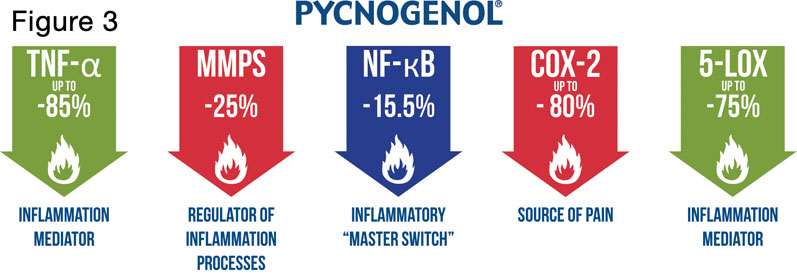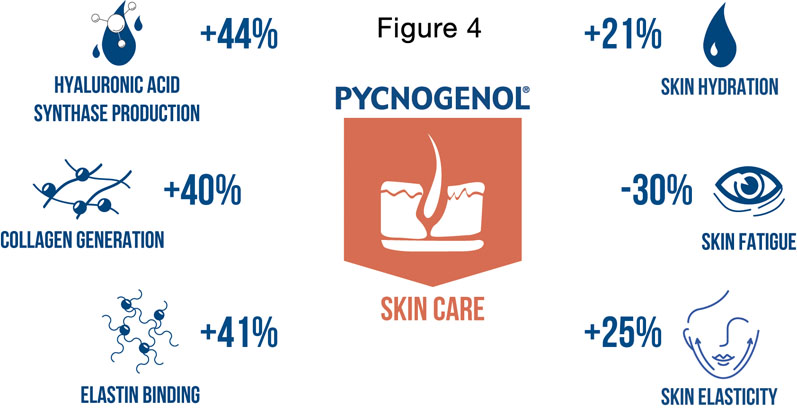Healthy microcirculation is vital as it leads to a well-functioning supply of nutrients and oxygen to all parts of the body.
In several previously published studies, Pycnogenol was shown to improve blood circulation in small blood vessels in the body, such as the very fine microvessels in the skin, fingertips and in the inner ear or the retinal capillaries in the eye.5,26–29,32–35
In a 3-month study on diabetic retinopathy, Pycnogenol supplementation improved the retinal blood flow by approximately 30% compared with no change in the control patients.5
In another study with patients suffering from coronary heart disease, microcirculation in the fingertip improved significantly in 54% of the patients taking Pycnogenol and in 33% of the placebo patients after 4 weeks.29
Pycnogenol helps to break the cycle of inflammation and oxidative stress
The anti-inflammatory and antioxidant properties of Pycnogenol further contribute to the versatile nature of the ingredient on body health and beauty. Inflammation and oxidative stress are closely linked processes in the body.

Oxidative stress can trigger inflammation, which, in turn, can lead to more oxidative stress.42 Initially, inflammation is a complex protective response of the body to harmful stimuli and is part of innate immunity.
However, too much inflammation can be chronic — the basis of various diseases such as atherosclerosis, arthritis or allergies.
Pycnogenol controls inflammation
In several studies, it was shown that Pycnogenol has inflammation-reducing properties.15–17 The consumption of Pycnogenol was shown to significantly limit the activation of the proinflammatory “master switch” NF-kB by 15.5% and matrix metalloproteinase 9 (MMP-9) release by 25%.
These are two important regulators in the inflammation process (Figure 3). This positive effect thus helps to prevent the mobilisation of proinflammatory molecules, which play a destructive role in arthritis.
In another study, Pycnogenol significantly prevented the up-regulation of the proinflammatory enzymes 5-LOX and COX-2 after only five days of daily intake.15,16
In addition, the consumption of a single dose of 300 mg of Pycnogenol was found to naturally inhibit the generation of COX-2 enzymes during inflammation in humans, thus providing a significant way to reduce pain.17
These beneficial effects of Pycnogenol were also observed in clinical studies with patients suffering from different chronic inflammatory conditions such as knee osteoarthritis, endometriosis or allergic rhinitis.4,43–46 Pycnogenol was shown to promote joint mobility and flexibility and naturally relieve pain.
Pycnogenol is a powerful antioxidant
Pycnogenol has been investigated in various clinical studies and shown to possess potent antioxidant properties.1,2,9–14
Pycnogenol, when taken orally, has been shown to both increase plasma antioxidant capacity — expressed as oxygen radical absorbance capacity — and decrease plasma oxidative stress — measured as plasma free radicals.11,49
Pycnogenol has further been shown to protect lipids from peroxidation by free radicals in elderly people and people with coronary artery disease.1,2
The protective effect of Pycnogenol on DNA oxidation was shown in a randomised, double-blind placebo-controlled study of children with ADHD by measuring the level of oxidised purines.9
Pycnogenol strengthens the extracellular matrix in skin, joints and other tissues
The extracellular matrix consists of a complex mixture of proteins, glycoproteins, proteoglycans and other molecules. It plays a vital role in various connective tissues, functioning as a supportive framework.
It provides mechanical support to tissues, regulates cell behaviour and influences tissue development and repair. Collagen and elastin are crucial components of the skin’s extracellular matrix. Collagen provides structural support and firmness to the skin, whereas elastin ensures its elasticity.
Hyaluronic acid contributes to skin hydration by retaining moisture. These molecules collectively promote youthful, healthy skin and can help to address issues related to ageing.
In addition, collagen is a significant component of cartilage, which covers and protects the ends of bones in joints. It contributes to joint stability and flexibility. Hyaluronic acid is also found in joint fluid and lubricates and cushions the joints, allowing for smooth movement.

Pycnogenol improves skin hydration and elasticity
Pycnogenol was shown to increase skin elasticity and reduce skin fatigue by stimulation of the synthesis of new collagen and hyaluronic acid in the skin and inhibiting the activity of enzymes that break down collagen and elastin.6,16,18,19
Pycnogenol further protects skin proteins against enzymatic degradation by selectively binding to elastin and collagen (Figure 4).19
Clinical investigations of Pycnogenol supplementation for 12 weeks with female volunteers aged 55–68 revealed increased hyaluronic acid synthase levels within the skin by 44%, leading to improved skin hydration.19
Hyaluronic acid synthase is the natural source of water-binding hyaluronic acid in the dermis, which moisturises the skin and keeps it taut and smooth.
Consequently, an average skin-hydration increase by 21% in the group of Pycnogenol supplementation was found, particularly in women presenting with dry skin prior to Pycnogenol intake.
In this study, Pycnogenol was also shown to improve skin elasticity by 25% and decrease skin fatigue by 30%. Interestingly, the results were paralleled by Pycnogenol’s ability to generate skin’s connective tissue collagen by an average of 40%.
In addition to stimulating the synthesis of new collagen, Pycnogenol metabolites can inhibit the release and activity of destructive enzymes (metalloproteinases 1, 2 and 9), which break down dermal tissue proteins such as collagen or elastin.16,19
The reduced activity of these lytic enzymes saves the connective tissues from degradation, representing the basis for maintaining an elastic, smooth and youthful looking skin. The beneficial effects of Pycnogenol on the skin have been confirmed in several clinical studies.
Pycnogenol has beneficial effects on joint function
Pycnogenol has been shown to act beneficially in patients presenting with joint problems.43,49–51
In a study with 33 patients suffering from severe osteoarthritis, a joint cartilage damaging condition, the level of matrix metalloproteinases (MMP) enzymes that are responsible for destroying cartilage in joints was significantly downregulated in the fluid around the knee joints after taking Pycnogenol.44
These results confirm previous findings that the regular intake of Pycnogenol leads to a potent decrease of proinflammatory markers such as NF-κB, COX-enzymes and MMPs.15–17,19
In most cases, joint pain is caused by damage to the articular cartilage. Hyaluronic acid contributes to the shock-absorbing abilities of cartilage.
As Pycnogenol significantly increased the gene expression of hyaluronic acid synthase, this is helpful not only for skin but also for articular cartilage.18
Additionally, the abilities of Pycnogenol to increase the synthesis of collagen and to protect it from degradation are crucial for joint health (collagen is an important component of articular cartilage).

These results are backed up by a strong increase of the concentration of Pycnogenol’s metabolites in the synovial fluid surrounding articular cartilage in the joints in osteoarthritis patients.44,52
In this way, the active ingredients of Pycnogenol can act directly where they are needed. This comprehensively explains how Pycnogenol contributes to restoring health in damaged joints.
Pycnogenol French pine bark extract is one of the most widely investigated natural supplements worldwide with convincing data for various fields of application, including heart health, skincare, cognitive function and allergy control.
Pycnogenol is a standardised complex mixture of many molecules and has shown beneficial efficacy on blood circulation, strong anti-inflammatory and antioxidant effects and impressive action on the integrity of tissues.
References
42. L. Zuo, et al., “Inflammaging and Oxidative Stress in Human Diseases: From Molecular Mechanisms to Novel Treatments,” International Journal of Molecular Sciences 20(18), 4472 (2019).
43. P. Cisar, et al., “Effect of Pine Bark Extract (Pycnogenol) on Symptoms of Knee Osteoarthritis,” Phytother. Res. 22(8), 1087–1092 (2008).
44. S. Jessberger, et al., “Cellular Pharmacodynamic Effects of Pycnogenol in Patients with Severe Osteoarthritis: A Randomized Controlled Pilot Study,” BMC Complement. Altern. Med. 17(1), 537 (2017).
45. T. Kohama, K. Herai and M. Inoue, “Effect of French Maritime Pine Bark Extract on Endometriosis as Compared with Leuprorelin Acetate,” J. Reprod. Med. 52(8), 703–708 (2007).
46. H. Maia, Jr, C. Haddad and J. Casoy, “Combining Oral Contraceptives with a Natural Nuclear Factor-Kappa B Inhibitor for the Treatment of Endometriosis-Related Pain,” Int. J. Womens Health 6, 35–39 (2013).
47. G. Belcaro, et al., “Pycnogenol Improvements in Asthma Management,” Panminerva Med. 53(3), 57–64 (2011).
48. G. Belcaro, et al., “A Controlled Study Shows Daily Intake of 50 mg of French Pine Bark Extract (Pycnogenol) Lowers Plasma Reactive Oxygen Metabolites in Healthy Smokers,” Minerva Medica 104(4), 439–446 (2013).
49. G. Belcaro, et al., “Variations in C-Reactive Protein, Plasma Free Radicals and Fibrinogen Values in Patients with Osteoarthritis Treated with Pycnogenol,” Redox Rep. 13(6), 271–276 (2008).
50. R. Farid, et al., “Pycnogenol Supplementation Reduces Pain and Stiffness and Improves Physical Function in Adults with Knee Osteoarthritis,” Nutrition Research 27(11), 692–697 (2007).
51. G. Belcaro, et al., “Treatment of Osteoarthritis with Pycnogenol. The SVOS (San Valentino Osteo-Arthrosis Study). Evaluation of Signs, Symptoms, Physical Performance and Vascular Aspects,” Phytother. Res. 22(4), 518–523 (2008).
52. M. Mülek, et al., “Distribution of Constituents and Metabolites of Maritime Pine Bark Extract (Pycnogenol) into Serum, Blood Cells, and Synovial Fluid of Patients with Severe Osteoarthritis: A Randomized Controlled Trial,” Nutrients 9(5),443 (2017).
Citations 1–41 can be accessed in Part I of this article.
